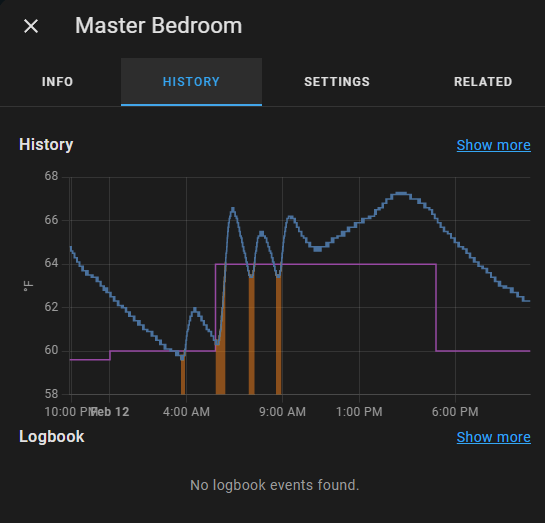I happened to have a VIVOSUN Digital Heat Mat Thermostat Temperature Controller we’re not currently using from the greenhouse. I did some quick testing:
- Put the VIVOSUN between the wall outlet and the Jotul with a setpoint of 69F.
- Turned the generic_thermosat up until it barely turned on with the setpoint of 65.5F. Jotul turned on with Flame:6.
- Unplugged the BroadLink from the wall.
- The temperature raised above the setpoint, and the generic_thermostat went to idle, but the Jotul stayed running since it didn’t get the Flame:0 command.
- The temperature in the room continued to rise, and when it hit 70.5F or so on the VIVOSUN, power was removed from the Jotul and all the valves closed and I would consider the stove safe, like if the power had failed.
- When the temperature came back down below the setpoint, the Jotul powered back on, beeped and clicked a few times but remained off.
I need to do some tweaking to get the VIVOSUN setpoint high enough that it won’t be triggered by normal use, but low enough that it will failsafe before wasting a ton of fuel or overheating the space. I will also probably need to buy another similar thermostatic outlet, as I’m sure this or the replacement will be needed again in the greenhouse.
The good news with this solution is that it shouldn’t turn back on until the control channel that failed is fixed and Home Assistant can send another Flame: command to turn it back on.
Updated the next day:
I made another improvement today. I had been playing with RF codes from the Proflame remote with Thermostat:1, Pilot:1, Fan:0, Flame:0 for off, and just toggling Flame:6 (high) for on. All the other Light, Power, Front, Aux values were also 0 (off).
I created a second Helper: input_boolean.master_bedroom_quiet_time. I recorded a second set of RF codes, Thermostat: 1 and Pilot:1 remained, but for the “non-quiet” RF codes I have Fan:2 and toggle Flame:0 and Flame:1 (low) for on. Now I can not only control the on/off of the Jotul but depending on whether I have “Quiet Time” toggled it runs different presets.
For those that haven’t experienced the joy of these units, they’re a little on the loud side. If you use a lower flame setting the stepper motors(?) click a dozen or so times getting you there. It’s probably not something you’d really care about in a noisy room in the middle of the day, but if you’re trying to sleep it is quite annoying to me. The fan is also a little buzzy and while it’s running it can cause a vibration/rattle if the door is a little loose, or the grate on the top isn’t sitting tight.
I plan on creating a Quiet Time schedule, and have it toggle this value at a slightly different time than the schedule I have created for the thermostat setback. The cool thing is you can also toggle the switch manually, and then it’ll go back to the schedule during the next scheduled time event.
I was able to incorporate both the input_boolean state changes as well as an every 5 minute (/5) trigger into the same automation a set of if then else blocks under it. So now I have one single automation that will turn on or off or resend the current state RF code. Before I had an on Automation, and off Automation, and a resend Automation as I’m still learning the platform.
 thanks for pointing that out
thanks for pointing that out
